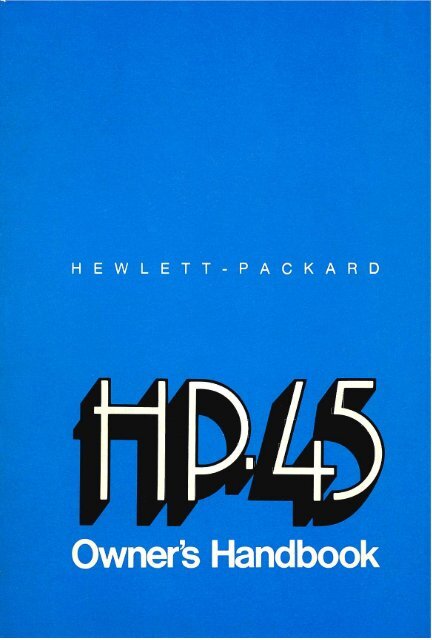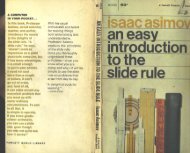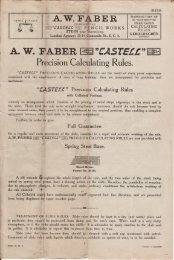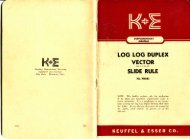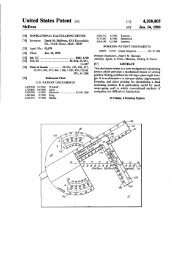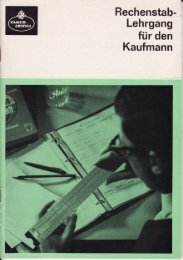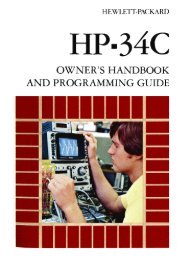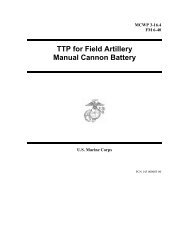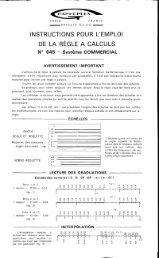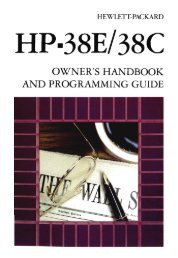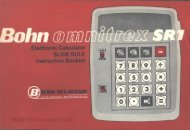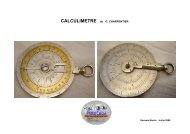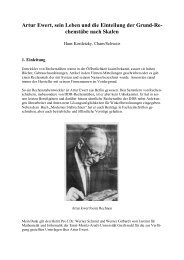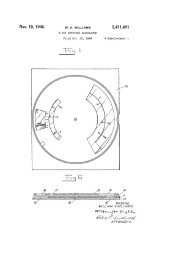HP-45 Owner's Handbook - Slide Rule Museum
HP-45 Owner's Handbook - Slide Rule Museum
HP-45 Owner's Handbook - Slide Rule Museum
You also want an ePaper? Increase the reach of your titles
YUMPU automatically turns print PDFs into web optimized ePapers that Google loves.
Hewlett-Packard's interest in computation evolved as a natural<br />
extension of our traditional involvement in measurement problem<br />
solving. At an early date, <strong>HP</strong> recognized the growing need for a<br />
family of computational products designed to work easily and<br />
effectively with scientific instruments.<br />
In 1966 we introduced the first digital minicomputer specifically<br />
designed to meet this need. Soon after, we followed up with our<br />
first programmable calculator. From these beginnings, <strong>HP</strong> has<br />
now become an acknowledged leader in the field of computational<br />
problem solving. More than 20,000 <strong>HP</strong> programmable calculators<br />
and digital computers are at work in a wide range of applications<br />
in science, industry, education, medicine, and business. Their effectiveness<br />
is further enhanced by a complete line of accessory<br />
devices, ranging from digital tape and disc drives to card and tape<br />
readers, printers, and plotters.<br />
Lately we've coupled our experience in scientific problem solving<br />
and computational technology to bring you new dimensions in<br />
personal computation-the <strong>HP</strong>-80 Business Pocket Calculator for<br />
solving problems in business and finance, the <strong>HP</strong>-35 Scientific<br />
Pocket Calculator for engineering/ scientific applications, and now<br />
the <strong>HP</strong>-<strong>45</strong> Advanced Scientific Pocket Calculator whose expanded<br />
functional capability and multiple storage registers allow complex<br />
problems to be handled with unprecedented ease.<br />
Attention Please!<br />
To give you more computing power, your <strong>HP</strong>-<strong>45</strong> works in a consistent<br />
and natural way that may be slightly different from previous<br />
calculators you have operated. Even though your new <strong>HP</strong>-<strong>45</strong> is<br />
simple to operate, and you can start solving problems immediately<br />
by following the Quick Reference Guide accompanying the <strong>HP</strong>-<strong>45</strong>,<br />
you will find it worthwhile to read this handbook.<br />
3
Table of Contents<br />
<strong>HP</strong>-<strong>45</strong> <strong>Owner's</strong> <strong>Handbook</strong><br />
Introduction ..... . . . . . . .. . . . .. . . .. . . .<br />
General Operating Instructions<br />
Fundamental Operations<br />
Getting Started .<br />
Keyboard<br />
Keying in and Entering Numbe rs<br />
Perfo rmi ng Sim ple Arithmeti c ..<br />
Correcting In put Erro rs.<br />
Cl ea ring ..... ........ .<br />
Using Di sp lay and Round in g Options.<br />
Keyi ng in Negative Num be rs ............... . .<br />
Keying in Exponents .<br />
Performing Simpl e Functions.<br />
Find ing Reciprocals<br />
Fi nding Square Roots<br />
Squaring Numbers<br />
Rai sing Numbers to Powers . .. . . . . • . . . ..<br />
Using Pi<br />
Us ing Factori als<br />
Calculat ing Percentage Problems.<br />
7<br />
9<br />
9<br />
9<br />
11<br />
11<br />
12<br />
13<br />
13<br />
14<br />
15<br />
16<br />
16<br />
16<br />
16<br />
16<br />
18<br />
18<br />
20<br />
Operational Stack. . . . . . . . . . . . . . . . . . . . . . . . • . . . . . . . . 21<br />
Stack Registers . . . . . . . . . . . 21<br />
Manipulating the Stack. 23<br />
Performing Combined Arithmetic Processes . 24<br />
Seri al Cal cu lation ........... . . 24<br />
Ch ained Calculation .. . ...... . 24<br />
Mixed Chained Calculation 25<br />
Last x Register ..... . .. . . . .. . .. . ... . .. .. . . ... .. .<br />
Data Storage Registers<br />
Unrestricted Storage<br />
Registers R, - R • ... ... . . ..• ... .. . . . . • . . • .. . . ..<br />
Restricted Storage . .. . ... .. . .<br />
Registers R, - R,<br />
Regi ster R •. .... . .. . ... . ....... . . . .<br />
Storing and Recalling Data ... .. . .. .. . .. . . . . . . . .<br />
Performing Register Arithmetic.<br />
4<br />
26<br />
26<br />
26<br />
26<br />
26<br />
26<br />
26<br />
27<br />
27
Metric/U.S. Unit Conversion Constants .<br />
Logarithmic and Exponential Functions<br />
Statistical Functions .<br />
Trigonometric Functions . ............ .<br />
Angul ar Modes. . ....... . . .. .<br />
Degrees-Minutes-Seconds Conve rsion.<br />
Polar/Rectangular Coordinate Conversion .<br />
Operating Limits .<br />
Accuracy .<br />
Underflow and Ove rflow Display Formats.<br />
Imprope r Operations. . ............... . .<br />
Appendixes :<br />
Stack Algorithm and Flowchart. <strong>45</strong><br />
3 1<br />
32<br />
34<br />
37<br />
37<br />
38<br />
39<br />
42<br />
42<br />
43<br />
44<br />
Hardware Specifications . . . . . . . . . . . . 47<br />
Temperature Range 47<br />
Battery Operation . . . . . . . . . . . . . . . . . . 47<br />
Recharging and AC Line Ope ration . 47<br />
Battery Pack Replacement. 48<br />
Accessories . 51<br />
Calculation Equations . 52<br />
Service and Warranty . 53<br />
Servicing.. . . .. . . ... . .. .. 53<br />
Low Power ..... . . .• ..• . .. .. . 53<br />
Blank Display .... . . . . . . . . . . . 53<br />
Warranty. . . . . . . . . . . . . . . . . . . . . . . . . . . . . . . . . . . . . . 53<br />
In Wa rra nty 53<br />
Out of Wa rranty ..... 53<br />
Shipping Instructions . . . . . . . . . . . . . . . . . . . 54<br />
Subject Index . ....... . . 55<br />
Keyboard Summary and Index . 58<br />
5
Introduction<br />
Little is understood about the methods used by calculating prodigies<br />
to perform their awesome feats. The method used by 10-yearold<br />
Truman Henry Safford in 1846 to calculate 365365365365<br />
365365' (as described by the Rev. H. W Adams) shows that difficult<br />
problems are difficult even for prodigies-" .. '. he flew around<br />
the room like a top, pulled his pantaloons over the tops of his<br />
boots, bit his hands, rolled his eyes in their sockets, sometimes<br />
smiling and talking and then seeming to be in an agony, until, in<br />
not more than one minute said he, 733,491,850,208,566,925,<br />
016,658,299,941 ,583,225!"<br />
Although your <strong>HP</strong>-<strong>45</strong> might not be as much fun to watch, it makes<br />
calculating faster and less arduous, because the operational stack<br />
and the reverse "Polish" notation used in the <strong>HP</strong>-<strong>45</strong> provide the<br />
most efficient way known to computer science for evaluating<br />
mathematical expressions.<br />
The <strong>HP</strong>-<strong>45</strong> has far more computing power than previous pocket<br />
calculators. Its accuracy exceeds the precision to which most of<br />
the physical constants of the universe are known. It will handle<br />
numbers as small as 10- on , as large as 10"", automatically places<br />
the decimal point, and allows 20 different options for rounding the<br />
display to provide greater flexibility and convenience in interpreting<br />
results. The <strong>HP</strong>-<strong>45</strong> provides you with transcendental functions,<br />
such as logarithms, sines and cosines; polar/ rectangular<br />
coordinate conversions for handling complex arithmetic, vectors;<br />
selective operating modes; and multiple storage registers. Additionally,<br />
constants for 'iT and e are provided- as well as three<br />
metric/U.S. unit constants for conversions between centimeters/<br />
inches, kilograms/ pounds, and liters/ gallons. Furthermore, statistical<br />
capabilities for calculating the mean (arithmetic average)<br />
and standard deviation are incorporated in the <strong>HP</strong>-<strong>45</strong>.<br />
7
Mixed Chained Calculation<br />
Chained calculations can use any arithmetic operator-divide and subtract<br />
as well as multiply and divide. Additionally, a problem may be<br />
calculated with any combination of arithmetic operators in both nested<br />
and linked operations. For example, to calculate<br />
[ { (12 X 5) - 2 } + { (8 --:-- 2) + 10 } 1 X (213 .08 X 5 --:-- 1.33) --:-- 2<br />
Press: See displayed:<br />
You may find the flow chart in Appendix A interesting. It describes a<br />
procedure (an algorithm) that will allow you to evaluate any expression<br />
on a calculator, such as your <strong>HP</strong>-<strong>45</strong>, that uses an operational stack and<br />
reverse Polish notation.<br />
25
Temperature Range<br />
Appendix B<br />
Hardware Specifications<br />
Mode Temperature °C<br />
Operating O°C to 50°C<br />
Charging 10°C to 40°C<br />
Storage - 40°C to 55°C<br />
Temperature of<br />
32°F to 122°F<br />
50°F to 104°F<br />
- 40°F to 131°F<br />
Battery Operation<br />
Use only the <strong>HP</strong> Rechargeable Battery Pack, Model 82001A, which<br />
has been tested and is warranted for one year. The battery provides<br />
three to five hours of continuous operation. By turning off the power<br />
when the calculator is not in use, the <strong>HP</strong>-<strong>45</strong> battery power will last<br />
easily throughout a normal working day.<br />
All decimal points light in the display when 2 to 5 minutes of operation<br />
time remain in the battery pack. Even when all decimal points are<br />
turned on, the true decimal position is known because an entire digit<br />
position is allocated to it.<br />
Example:<br />
l True decimal position<br />
Operating the calculator for more than 2 to 5 minutes after this low<br />
power indication first occurs may result in calculation errors. The battery<br />
pack must be recharged by connecting the <strong>HP</strong>-<strong>45</strong> to its battery<br />
charger e<strong>HP</strong> Model 82002A).<br />
Recharging and AC Line Operation<br />
The <strong>HP</strong>-<strong>45</strong> should be turned off before plugging in the charger. It can<br />
be turned on again after the charger is plugged into the power outlet<br />
and can be used during the charging cycle. The <strong>HP</strong>-<strong>45</strong> can be operated<br />
continuously from the AC line if desired. There is no danger of overcharging<br />
the battery.<br />
After 14 hours, a completely discharged battery will be fully charged.<br />
Shorter charge periods will allow reduced battery operating time. For<br />
convenience, overnight charging is recommended.<br />
47
CAUTION<br />
To prevent damage to the calculator, the position of the<br />
line voltage select switch on the battery charger must<br />
be set to the proper line voltage.<br />
1. Turn the <strong>HP</strong>-<strong>45</strong> power switch to OFF.<br />
2. Insert battery charger plug into the rear connector of the <strong>HP</strong>-<strong>45</strong><br />
and insert power plug of battery charger into the power outlet. The<br />
<strong>HP</strong>-<strong>45</strong> will not operate when connected to the recharger unless the<br />
recharger is connected to a live power outlet.<br />
3. <strong>Slide</strong> the power switch to ON, see that 0.00 is displayed.<br />
4. <strong>Slide</strong> power switch to OFF if you don 't want to use the calculator<br />
while it is charging.<br />
5. At end of the charging period, you may continue using your <strong>HP</strong>-<strong>45</strong><br />
with AC power or proceed to next step for battery operation.<br />
6. With the power switch at OFF, disconnect battery charger from<br />
power receptacle and the battery charger from <strong>HP</strong>-<strong>45</strong>.<br />
Temporary degradation, peculiar to nickel-cadmium batteries, may<br />
cause a decrease in the operating period of the battery pack. Should<br />
this happen turn the <strong>HP</strong>-<strong>45</strong> on for at least five hours to discharge the<br />
batteries completely. Then put it on charge for at least 14 hours. This<br />
should correct the temporary degradation.<br />
If the battery pack won't hold a charge, it may be defective. If the<br />
warranty is in effect, return the pack to Hewlett-Packard according<br />
to the instructions on page 54. If the battery pack is out of warranty,<br />
use the accessory order card, provided with your <strong>HP</strong>-<strong>45</strong>, to order a<br />
new battery. Remember, you can use your <strong>HP</strong>-<strong>45</strong> on AC power until<br />
the replacement battery pack arrives.<br />
Battery Pack Replacement<br />
1. Turn power switch to OFF and disconnect the battery charger.<br />
2. <strong>Slide</strong> the two battery-door latches (the top feet) toward middle of<br />
calculator.<br />
48
3. Let battery door and batterypack<br />
fall into palm of hand.<br />
5. Insert the battery pack so that<br />
its contacts face the calculator<br />
and contact is made with<br />
battery connectors.<br />
49<br />
4. See if the battery connector<br />
springs on the calculator have<br />
been inadvertently flattened<br />
inward. If so, bend them out<br />
and try the battery again.
7. Close the battery door by pressing<br />
it gently while sliding the<br />
two battery-door latches<br />
outward.<br />
6. Insert the bottom of the<br />
battery door behind the<br />
refaining groove and close<br />
the door.<br />
NOTE: If you use your <strong>HP</strong>-<strong>45</strong> extensively in field work or during<br />
travel, you may want to order the Model 82004A Battery Holder<br />
and Pack, consisting of battery charging attachment and spare<br />
battery pack. This enables you to charge one pack while using<br />
the other.<br />
CAUTION<br />
Do not try to burn old batteries. They may EXPLODE!<br />
50
Appendix C<br />
Accessories<br />
Standard and optional accessories for the <strong>HP</strong>-<strong>45</strong> can be ordered by<br />
completing and mailing the order card provided. We will send you additional<br />
order cards as new optional accessories are added to our<br />
product line.<br />
Standard Accessories<br />
<strong>HP</strong>-<strong>45</strong> Quick Reference Guide<br />
Battery Pack<br />
Battery Charger/ AC Adapter<br />
Deluxe Travel Safety Case<br />
Soft Carrying Case<br />
<strong>HP</strong>-<strong>45</strong> <strong>Owner's</strong> <strong>Handbook</strong><br />
Personalizing Labels (4 each)<br />
Optional Accessories<br />
Battery Holder and Pack<br />
Security Cradle<br />
Hard Leather Field Case<br />
51<br />
Model/Pari No.<br />
000<strong>45</strong>-90303<br />
82001A<br />
82002A<br />
82014A<br />
82012A<br />
000<strong>45</strong>-90300<br />
7120-2946<br />
Model/Part No.<br />
82004A<br />
82007A<br />
82006A
Servicing<br />
Appendix E<br />
Service and Warranty<br />
Low Power<br />
All decimal points light to warn you that you have 2 to 5 minutes of<br />
operating time left. You must then either:<br />
• Operate from AC power<br />
• Charge the battery pack<br />
• Insert a fully charged battery pack<br />
Blank Display<br />
If the display blanks out, turn the <strong>HP</strong>-<strong>45</strong> off then on. If 0.00 does not<br />
appear on the display, check the following:<br />
1. If battery charger is attached to <strong>HP</strong>-<strong>45</strong>, make sure it is<br />
plugged into outlet.<br />
2. Examine battery pack to see if it is discharged or is not<br />
making contact.<br />
3. If display is still blank, try operating the <strong>HP</strong>-<strong>45</strong> from the AC line.<br />
4. If, after step 3, display is still blank, the <strong>HP</strong>-<strong>45</strong> is defective<br />
(see warranty section).<br />
Warranty<br />
In Warranty<br />
The <strong>HP</strong>-<strong>45</strong> is warranted against defects in materials and workmanship<br />
for one year from date of delivery. During the warranty period we will<br />
repair or replace components that prove to be defective, provided they<br />
are returned to Hewlett-Packard according to instructions (see Shipping<br />
Instructions). No other warranty is expressed or implied. We are<br />
not liable for consequential damage.<br />
Out of Warranty<br />
Beyond the one-year warranty period, your calculator will be repaired<br />
for a moderate charge. Return the <strong>HP</strong>-<strong>45</strong> along with all standard accessories<br />
(see Shipping Instructions). If only the battery pack is defective,<br />
simply order a replacement on the Order Card provided.<br />
53
Shipping Instructions<br />
Malfunctions traced to the calculator or battery charger require that<br />
you return the following to us:<br />
• Your <strong>HP</strong>-<strong>45</strong> with all standard accessories in their travel<br />
safety case<br />
• A completed Service Card (from back cover pocket of this manual)<br />
If a battery pack is defective and within- warranty, return the following<br />
to us:<br />
• Only the defective battery pack<br />
• A completed Service Card (from back cOver pocket of this manual)<br />
Send returned items safely packaged to the address shown on the Service<br />
Card.<br />
Under normal conditions, your calculator will be repaired and reshipped<br />
within two days of receipt at this address. Should other problems<br />
or questions arise regarding service, please call the applicable<br />
service telephone number on the Service Card, or call Advanced Products<br />
Division, Customer Service, at (408) 996-0100.<br />
54
Subject Index<br />
Accessories, 51<br />
Accuracy, 42<br />
Addition function, 11<br />
Angular mode options, 37<br />
Antilog functions, 32, 33<br />
Arc cosine function, 37<br />
Arc sine function, 37<br />
Arc tangent function, 37<br />
Arithmetic operations: chained, 24; combined, 24; general description of,<br />
11; serial, 24<br />
Arithmetic: register, 27; vector, 40<br />
Battery: operation of, 47; recharging of, 47; replacement of, 48<br />
Battery condition, low, 47<br />
Battery pack, 9<br />
Calculation equations, 52<br />
Centimeters/inches conversion, 31<br />
Chained calculation, 24<br />
Changing sign, 14, 15<br />
Clearing operations: calculator, 13; data storage register, 26; display, 13;<br />
general description of, 13; last x register, 26<br />
Combinations, 19<br />
Combined arithmetic operations, 24<br />
Common antilog function, 33<br />
Common log function, 33<br />
Constants, preprogrammed: e, 33; metric/ U.S. unit conversion, 31; Pi, 18<br />
Controls: data manipulation, 12,23; data storage register, 27; display,<br />
9,13; operational, 9, 13, 14, 15, 22, 24; rounding, 13<br />
Conversion constants, 31<br />
Conversions: centimeters/ inches, 31; degrees-minutes-seconds, 38;<br />
kilograms/pounds, 31, 32; liters/ gallons, 31, 32; metric/ U.S. units, 31;<br />
polar/rectangular coordinates, 39<br />
Correcting input, 12, 26<br />
Cosine function, 37<br />
Cube root, 17<br />
Data: moving and manipulation of, 23; recalling, 27; storing, 27<br />
Data storage registers: control of, 27; general description of, 26;<br />
restricted, 26; unrestricted, 26<br />
Decimal, fixed , 13<br />
Decimal place setting, 13<br />
Degrees-minutes-seconds conversion, 38<br />
Degrees mode, 37<br />
Display: blank, 53; blinking, 9, 44; control of, 9, 13<br />
Display characters, 13<br />
Display formats: overflow, 43; underflow, 43<br />
Display modes: fixed decimal, 13; scientific notation, 13<br />
55
Display and rounding options, 13<br />
Division function, 11<br />
Dyadic operations, 46<br />
Dynamic range, 7, 44<br />
e, use of, 33<br />
Entry operations: exponents, 15; negative number, 14; numbers, 11<br />
Error: input, 9; rounding, 42<br />
Error correction, input, 12<br />
Error signal, 44<br />
Exchanging contents of x and y, 23<br />
Exponent: keying in and entering, 15; negative, 15<br />
Exponential functions, 16, 32, 33<br />
Factorial function, 18<br />
Fixed decimal display, 13<br />
Gold key, 9<br />
Grads mode, 37<br />
Hardware specifications, 47<br />
Input error correction, 12<br />
Interactive functions (see Summation Function)<br />
Keyboard, 9<br />
Keying in numbers, 11<br />
Kilograms/ pounds conversion, 31, 32<br />
Last x register, recalling, 12, 26<br />
Liters/U.S. gallons conversion, 31, 32<br />
Logarithmic functions, 32, 33<br />
Malfunctions, 53<br />
Mean function, 34<br />
Metric/ U.S. unit conversion constants, 31<br />
Mixed chained calculation, 25<br />
Mode: angular, 37; degrees, 37; grads, 37; radians, 37<br />
Monadic operations, 46<br />
Multiplication function, 11<br />
N atural antilog functions, 33<br />
Natural log function, 33<br />
Negative exponent, 15<br />
Negative numbers, keying in, 14<br />
Numbers: keying and entry of, 11; negative, 14; powers of, 16<br />
Operation improper, 9, 44<br />
Operational controls, 9, 13, 14, 15,22,24<br />
Operational stack: algorithm and flow chart of, <strong>45</strong>; general description of, 21<br />
Operating limits, 42<br />
Overflow display format, 43<br />
56
Percentage functions, 20<br />
Permutations, 19<br />
Pi (7T), 18<br />
Polar/ rectangular coordinates conversion, 39<br />
Power switch, 9<br />
Powers of numbers, 16<br />
Radians mode, 37<br />
Range: dynamic, 7, 44; temperature, 47<br />
Recalling data, 27<br />
Recalling Last x, 12<br />
Reciprocal function, 16<br />
Register arithmetic: general description of, 27; use of, as counter, 28; use<br />
of, in recall operations, 28; use of, in store operations, 27<br />
Registers: data storage, 26; Last x, 12,26; working storage , 21<br />
Roll down stack, 23<br />
Rounding, 13<br />
Rounding error, 42<br />
Scientific notation, 13, 14, 43<br />
Serial calculation, 24<br />
Service, 53<br />
Shipping instructions, 54<br />
Sign, changing of, 14, 15<br />
Sine function, 37<br />
Square root function, 16<br />
Squaring function, 16<br />
Stack: algorithm and flow chart of, <strong>45</strong>; manipulation of, 23; operation of,<br />
21; roll down of, 23<br />
Standard deviation function, 34<br />
Statistical functions, 34<br />
Storage registers: clearing of, 26; data, 26; restrictions on, 26;<br />
working, 21, 23<br />
Storing data, 27<br />
Subtraction function, 11<br />
Summation function: decrement using, 34; error correction in, 34; general<br />
description of, 34; increment usin g, 34; two dimensional, 34, 40;<br />
use of, in polar/ rectangular coordinates conversion, 40<br />
Tangent function, 37<br />
Temperature range specifications, 47<br />
Trigonometric angular mode options, 37<br />
Trigonometric functions, 37<br />
Underflow display format, 43<br />
Vector arithmetic, 40<br />
Working storage registers, 21, 23<br />
Warranty, 53<br />
57
Scan Copyright ©<br />
The <strong>Museum</strong> of <strong>HP</strong> Calculators<br />
www.hpmuseum.org<br />
Original content used with permission.<br />
Thank you for supporting the <strong>Museum</strong> of <strong>HP</strong><br />
Calculators by purchasing this Scan!<br />
Please to not make copies of this scan or<br />
make it available on file sharing services.


